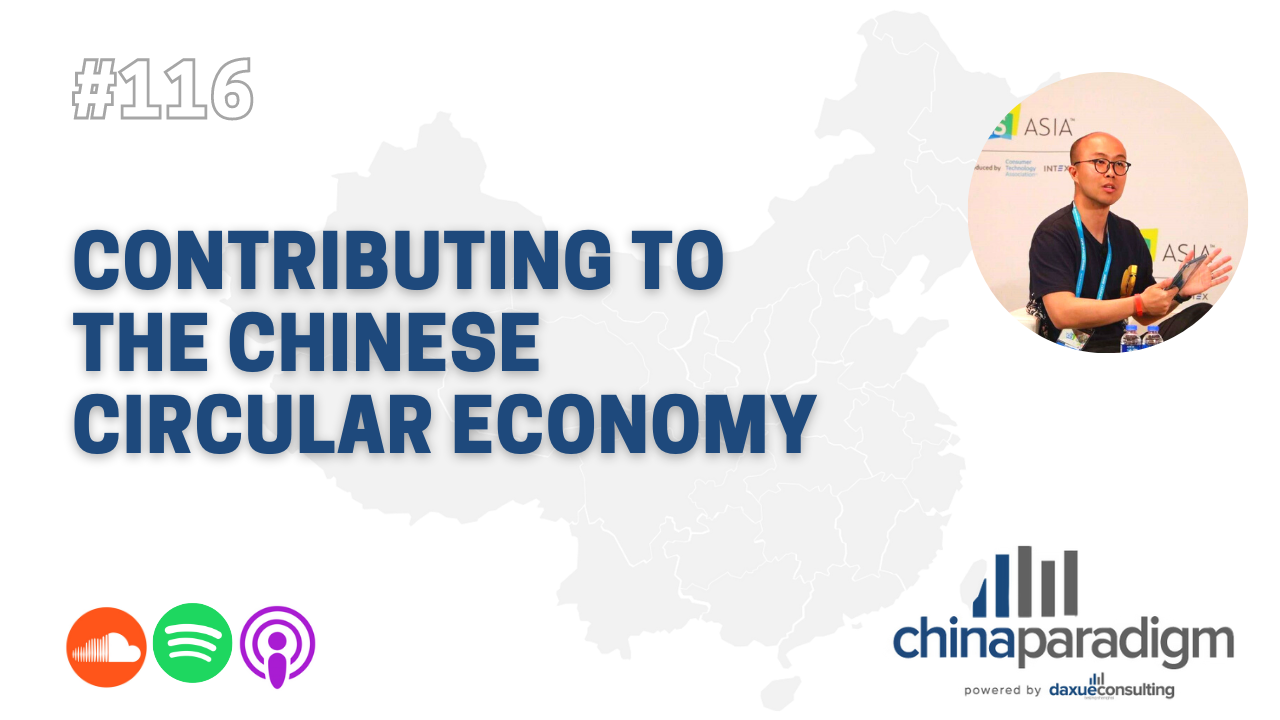Vincent Djen is involved in the garments industry in China. He is the Director of Cheng Kung Garments, a family started and ran business founded in 1975. They make garments for famous brands such as GANT, Filipa-K, GANNI. They have a team of around 20 people. They work with several garments factories in China. He is also the COO of REMAKEHUB, a start-up founded by his friend. It offers advice about sustainability in the apparel industry, particularly focusing on nylon garments made from ocean waste. He was also involved in founding a fashion brand, Black Eye Rags, with 2 other friends. He also advises start-ups in the garments industry in China.
Listen to the full China Paradigm episode 116 on Youtube, Apple Podcast, Spotify, Soundcloud, or Ximalaya.
How did the coronavirus outbreak affect the garment industry?
Vincent Djen: In most of the world, shops are still not open. In January, lots of orders were canceled. Orders numbers are coming back but not to pre-Covid levels.
Is the winter collection delayed as a result of the coronavirus outbreak?
Vincent Djen: Right now, it’s ok, not a huge effect.
The story behind Cheng Kung Garments
Vincent Djen: My parents started it in Hong Kong. Even though my parents were qualified in electronic engineering, there was an explosion in the textiles/ garments industry in China in the 70s, and they decided to start a company.
How and why did Vincent Djen decide to take over the family business?
Vincent Djen: I went to college in the US, and then I wanted to come home and take over. Even though I grew up around the factory and my parents often talked about business in front of me, I actually needed to learn a lot before I was ready to start managing a factory in the garments industry in China. But I thought I could bring some new and useful technological aspects into the business.
About Cheng Kung Garments, what is the current size of the business?
Vincent Djen: About 10- 11 million USD per year revenue. We make about 150 – 200,000 items per year.
What are the highs and lows of a season in the garments industry in China?
Vincent Djen: For us, peak season is late March to July
How do you manage low season in the garments industry in China?
Vincent Djen: You need to have a strong portfolio and a large customer base to ride out low periods. Also, you need to have one product that you are extremely good at producing and one or 2 other products that you are very good at producing. I liken good garments factories in China to Olympic swimmers. They maybe excel in the butterfly category but can also compete for a podium finish in the breaststroke and backstroke categories too.
How much of Cheng Kung Garments’ production is in-house and how much is outsourced?
Vincent Djen: We outsource about 66% of production to other garments factories in China, generally in Jiangsu, Zhejiang, Shandong, and Shanghai. We may be operating at anywhere from 30 to 60% of that factory’s capacity. I personally don’t visit them too much. Sometimes, I will go to build and strengthen relationships with factory owners or to take clients there, but I am not involved in doing any kind of quality control supervision. Other employees will do that when and if it’s needed.
Is China still the best place for the garments industry?
Vincent Djen: Yes, it has 38% of the global exports of garments. It has the best infrastructure and the deepest supply chains. Also, it has a massive domestic market, unlike some other South East Asian competitors. As a result of this huge market, there are large low-end, medium-end, and high-end markets. So, when exports take a hit for whatever reason, they can rely on the domestic market. Also, China has 4 seasons and different climate zones, which require different types of clothing. In the winter you need to produce heavy coats, in the Summer you need to produce light garments. This better prepares garments factories in China to serve markets abroad which have different climates. Expertise can be developed in these categories while serving domestic demand and can then be exported.
Why is the textile industry still so labor intensive?
Vincent Djen: In the last few years, we have seen automation start to enter garments factories in China. However, it’s difficult for robotic arms to work with soft products. But they have been improving in this regard, and the prices are coming down, so I think in the next 2 or so years, we will see a lot more robotic arms in garments factories in China.
What are the costs of using robotics for manufacturing instead of people?
Vincent Djen: Right now, the costs per robotic arm are hundreds of thousands of RMB. However, once the price drops to around 50-60,000 RMB, we will probably see many adoption by medium-sized garments factories in China.
What are the initial costs for entrepreneurs who would want to get into the textile industry?
Vincent Djen: Nowadays, MOQs have come down massively. When my parents started, MOQs could be as high as 50,000 pieces, but nowadays, 300 pieces can be fairly standard, and we are working on getting that number lower. So many buyers want smaller orders which are more unique, and garments factories in China have had to adapt to this demand.
Is there support from the Chinese government to encourage factories to come up with innovative and sustainable solutions?
Vincent Djen: In 2014, the government made it mandatory for more than 15,000 garments factories in China to publish real-time figures on their emissions. The 2025 plan pushes a more circular economy where factories will have to be less wasteful. In some coastal cities, the amount of water re-usage can be anywhere from 30 – 70%. It’s becoming cleaner and more eco-friendly. These new regulations do add costs, but they also give you tax incentives. Also, if you develop new technologies surrounding becoming more sustainable, you can apply for grants. We have applied for some grants, but we haven’t received any funding yet.
How is 3D printing helping the textile industry?
Vincent Djen: You can 3D knit a jumper which is done in one piece, rather than in 2 or 3, as was traditionally done.
How does recycling in the garments industry fit into the day-to-day activities of the Cheng Kung Garments factory?
Vincent Djen: We can make clothing items from recycled plastic pellets.
Mechanical vs. Chemical Recycling – how many times can a product be recycled?
Vincent Djen: With mechanical recycling in the garments industry, you can break a plastic apart and melt it back into pellets which can be used again to create recycled clothing, but it’s limited to being recycled maybe 2 times. However, with chemical recycling in the garments industry, you break the plastic down to its elements before reshaping it into nylon, so you can potentially recycle it an unlimited amount of times.
REMAKEHUB – what and why have specific products been picked for recycling in the garments industry in China?
Vincent Djen: We chose fishing nets that were collected from the ocean. The reason being that many plastic products have already found suitable recycling end goals but ocean nets haven’t. Many companies have recycled plastic bottles to make garments, but nets are more of a challenge. The reason is that plastic bottles are made from food-grade plastic, which is of high quality, whereas the plastic in fishing nets is mostly composed of nylon. Nylon is very tough but rigid as a material, so it takes more work to make it more flexible and softer for garments.
Why was adding traceability for waste products recycled by REMAKEHUB important?
Vincent Djen: We developed a blockchain application to track the nets which we could use. This not only helps to verify we are using recycled fishing nets but also helps build the brand story and with customer engagement, and then consumers can sell the clothing second hand.
REMAKEHUB – following the “Cradle to cradle” design concept
Vincent Djen: For recycling in the garments industry, cradle to cradle refers to the circular process of creating products, using the waste from the product to create in other production areas.
Are big fashion brands already engaged in recycling in the garments industry?
Vincent Djen: Yes, Adidas, Patagonia, and PRADA are companies that make recycled products from both fishing nets and plastic bottles
Is it easy to tell if a finished product is made from recycled materials or not?
Vincent Djen: Not without machines; that’s another reason we want to add the traceability feature to our recycled garments.
Is recycling significant for brands that want to attract Chinese consumers, or is it still an afterthought for consumers?
Vincent Djen: Yes, I think the next few years will see a lot of growth in recycling in the garments industry in China. Covid will probably have the effect of speeding this up.
Are Chinese consumers buying recycled clothing already specifically because they are more sustainable?
Vincent Djen: Yes, it’s no longer just a Shanghai or Tier 1 city thing to do. We are seeing Chinese consumers buying recycled clothing all across China, and the trend of buying recycled products is becoming more mainstream.
What were the challenges you encountered when creating a brand in the fashion industry?
Vincent Djen: We tried creating a brand in the UK, but it didn’t make financial sense with BREXIT and the subsequent drop in the exchange rate. This was despite the fact that we had actually signed some contracts with ASOS and Harvey Nichols.
What is Vincent Djen’s greatest business goal?
Vincent Djen: I suppose I just want to help a little bit in making things more sustainable
What books have inspired Vincent Djen in his entrepreneurial journey?
Vincent Djen: One book which I found interesting was The Sum Of All Things about consumer behavior.
What does Vincent Djen read to stay up to date with China?
Vincent Djen: I just watch the news, a lot of news. National news and regional news in Shanghai and Zhejiang
What productivity tool does Vincent Djen use to run his business?
Vincent Djen: On WeChat, I use the reminders, but it can be unproductive because of all the message notifications.
What unexpected business success or failure has Vincent Djen witnessed in China?
Vincent Djen: The success of the KFC and the metro system in Shanghai. Also, Tesla seems to be doing very well in China. Some unsuccessful cases were probably some of the fashion brands that came and failed. They perhaps didn’t update their brand image enough.
Listen to the full China Paradigm episode 116 on Youtube, Apple Podcast, Spotify, Soundcloud, or Ximalaya.





